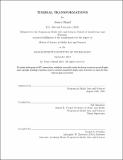| dc.description.abstract | From folk songs to festivals, cafes to concert halls, and religious rituals to recording studios, the flute has long had a shapeshifting, cross-cultural presence. This thesis leverages 21stcentury technologies not only to explore and extend the timbral versatility of flutes, but also to underscore the performative, fluid, and ever-evolving nature of timbre more generally. At the core of the project is the creation of sequences of discrete sounds that interpolate between semantic categories and a collection of fixed media compositions based on those sequences, both of which consist entirely of flute sounds that have undergone varying degrees of electronic manipulation. By means of digital signal processing techniques, the flute wavers in and out of a multitude of sonic identities. Sometimes, it masquerades as another familiar object or interface (e.g., a ticking clock) or abstractly evokes a concept or phenomenon (e.g., a storm); at other times, it beckons toward the ethereal or ineffable, resisting indexical identification altogether. With source materials warped, layered, and splayed across the frequency spectrum, such concerns as “the real” and “the true” begin to move out of focus, making way for attention to embodied phenomenological experiences of sound. As this thesis positions compositional practice as a form of research, its outputs range from the conceptual to the creative and the computational. In addition to the music at its core, the project interfaces with gender studies in its original exposition on timbre and timbral identity, includes a rigorous set of experiments with human and machine listeners, and makes original applications of multimodal language models not before seen in musicology or music theory. A live performance incorporating each of these project vectors and an audience discussion following the event offer further opportunities for reflection and critique. | |
